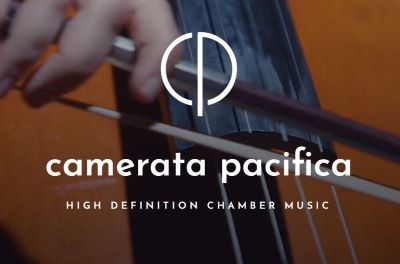STRING THEORY
Arnold Schoenberg‘s Verklärte Nacht (“Transfigured Night”), Op. 4, is a string sextet in one movement composed in 1899. Love him or hate him (some of his challenging later music is impenetrably inaccessible given his twelve-tone technique), there are times when Schoenberg’s system of composition can reach through your soul, creating an otherworldly sound. (American composer Scott Bradley, who scored MGM’s theatrical cartoons including Tom & Jerry, often used the twelve-tone system for composing the zany, what he called “funny music.”)
Camerata Pacifica players performing Arnold Schoenberg's Verklärte Nacht
The sextet began Camerata Pacifica‘s concert romantic program last week, which played four locales March 10-15, 2024, but first Artistic Director Adrian Spence read aloud the mystical poem by Richard Dehmelon on which it is based. In cold, moonlit woods, a woman confesses to her lover that she carries the child of another man she never loved but to whom she yielded for fulfillment. After a long pause of brooding meditation, he resolves that their love will make the child their own. They embrace and walk on, the formerly barren night transformed by hope and devotion.
Camerata Pacifica Artists performing Brahms Quintet
Such a lovely and dramatic delivery. I was already verklempt as the piece began. The stupendous and awesome musicians became a living, breathing organism of passion. It was uncanny, but I could actually sense feeling from the strings of Abigél Králik (violin), Jason Uyeyama (violin), Meredith Crawford (viola, Principal of Orange County’s Pacific Symphony), Che-Yen Chen (viola), Ani Aznavoorian (cello) and Coleman Itzkoff (cello). Wonderfully intense, with consistently bright timbres, I knew I was witnessing one of the best performances I’ve ever heard. Bringing out the inner voices with an almost unbelievable six-dimensional quality, this is music-making at the very peak of perfection, both technically and interpretively. Probably inspired by Brahms and Wagner, the piece is definitely Schoenberg. Listening to this rapturous interpretation reminded me of a phrase heard from a musicologist: “Wagner sees love as death; Schoenberg sees love as forgiveness.” Itzkoff’s intense sawing actually rumbled the intimate hall at The Huntington in San Marino. So much so, that I thought his strings would break.
Gilles Vonsattel and Ani Aznavoorian
Well, his didn’t, but at some ten minutes into the piece, Crawford’s pitch-perfect plunking suddenly created a dreaded “thud” sound. A string on her viola broke. This is the first time in my long-going concert attendances that I have ever seen this happen. With a polite but grieved nod to the first violin, she walked offstage followed by Chen. Personally, I would have been fascinated had they restrung the instrument in front of the viewers, as most of us have no idea how that’s done. Itzkoff asked if anyone knew a joke. I almost rose up immediately with a real doozy, but it just seemed so inappropriate in front of players of this magnitude.
After quite a bit of time, the violists reentered and Králik had them start from the top. But without getting up and shaking it off, I’m afraid to say that the sextet never regained the magic of that first ten minutes. Perhaps an outfit that had played together for years could have picked up from there, but it just didn’t happen. Sadly, it seemed to affect the reading of Brahms‘ Piano Quintet in F Minor, Op. 34 as well, a quintet which bookended the intermissionless program with pianist Gilles Vonsattel but sans Ms. Crawford, who will most likely never forget her debut with Camerata Pacifica. The Brahms was eloquent and expansive, but unfortunately not thrilling. In my many years at Camerata Pacifica, this has never happened, so don’t let this account keep you away. (If anyone saw the other three performances, I’d love to know what you thought.) When a viola string breaks in an orchestra, the instrument is relayed to the last person in the section.
What did manage to stand out quite well between the two group pieces was a well-known work by Arvo Pärt: Spiegel im Spiegel (“Mirror in the Mirror”), The work was composed in 1978 for Violin and Piano (however, it exists in other combinations too, which typically include a solo instrument and piano). Written in his “tintinnabular” style, it’s nothing like some of his other works, which can be aggressively modernistic. The short piece is an ideal introduction to the unique, meditative world of Pärt, where each ascending melodic line is followed by a descending mirror phrase. Vonsattel’s gentle piano arpeggios took us into a world of stillness, consolation and contemplation. With astounding clarity and strictness, Králik offered the melody while Vonsattel’s three-note piano accompaniment enraptured. It is not easy to play, as the structure of the piece follows a strict formula, where no note is left to chance. Králik’s auspicious Camerata Pacifica debut positively astounded me.
Ani Aznavoorian
photos by Craig T. Mathew/Mathew Imaging @mathewimaging
Next Concert
“Camerata Pacifica Baroque: The French Dispatch”
Sunday, April 21, 3 pm
Scherr Forum Theatre, 2100 E. Thousand Oaks Blvd, Thousand Oaks, CA 91362
Tuesday, April 23, 7:30 pm
The Huntington’s Rothenberg Hall, 1151 Oxford Rd, San Marino, CA 91108
Thursday, April 25, 8 pm
Zipper Hall, The Colburn School, 200 S Grand Ave, Los Angeles, CA 90012
Friday, April 26, 7:30 pm
Hahn Hall, Music Academy, 1070 Fairway Rd, Santa Barbara, CA 93108
for tickets ($75-$80), call 805-884-8410 or visit Camerata Pacifica
Emi Ferguson (Tim Norris)
Emi Ferguson, music director/flute
Karim Sulayman, tenor
Rachell Ellen Wong, violin
Doug Balliett, viola da gamba
Stephen Stubbs, guitar
Michael Sponseller, harpsichord
Program:
RAMEAU Pièces de Clavecin en Concert, Third Suite in A Major
CLÉRAMBAULT Pirame et Tisbé
Mde. GUÉDON DE PRESLES
“Tendres Amants,” “Vole Amour,” “Belle Catin,” “Je rencontray l’autre jour”
TELEMANN Paris Quartet No. 12 in E Minor, TWV 43:e4

